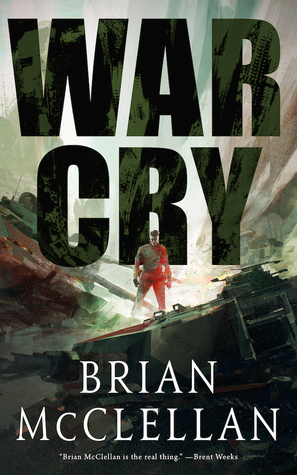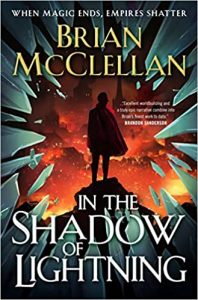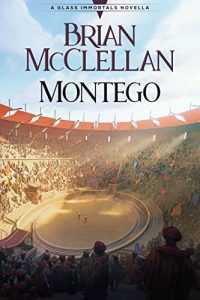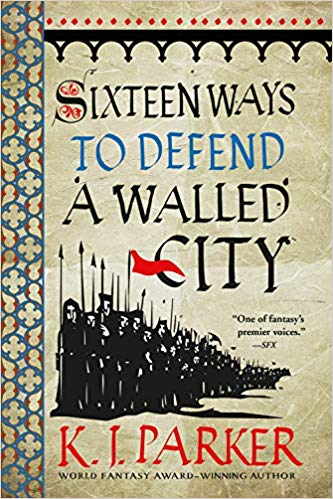 The Runes of Engagement by Tobias S. Buckell, Dave Klecha
The Runes of Engagement by Tobias S. Buckell, Dave Klecha Format: eARC
Source: supplied by publisher via Edelweiss
Formats available: paperback, ebook
Genres: military fantasy, military science fiction, portal fantasy
Pages: 279
Published by Tachyon Publications on June 18, 2024
Purchasing Info: Author's Website, Publisher's Website, Amazon, Barnes & Noble, Kobo, Bookshop.org, Better World Books
Goodreads
The Lord of the Rings meets Slaughterhouse-Five by way of World of Warcraft in this delirious mashup pitting the U. S. military against legendary monsters from fantasy novels and roleplaying games. From science fiction award-winner and an author, ex-Marine, and extreme amateur-landscaper, comes a riotous fantasy/military science fiction adventure that will delight fans of Terry Pratchett, J. R. R. Tolkien, and John Scalzi.
Of course, no one was prepared for the day when orcs, trolls, and dragons fell from portals in the sky. But the world fought back against the invaders as best it could, with soldiers, tactical weapons, and even some rudimentary magic.
Now a tough, but not-quite-prepared platoon of Marines is trapped on the wrong side of the portals. The enchanting landscape looks like Middle Earth, but―to the dismay of the nerdiest soldiers―is nothing like the Middle Earth they had loved.
This so-called fantasy world has much to throw at the legendary monsters, extremely rude trees, a mysterious orphan, treacherous mercenaries, and even a cranky, sort of helpful Ranger.
As their supplies dwindle and the terrain becomes even more hostile, the squad must also escort a VIP (Very Important Princess). She could be the key to a strategic alliance between the worlds, but only if the Marines can just make it home.
My Review:
I didn’t think they made them like this anymore. They certainly haven’t for a long, long time. And hot damn this was fun!
The Runes of Engagement is a portal fantasy – but on steroids. With weapons and monsters of mass destruction on both sides of the portal. Or rather, PORTALS, plural. And seemingly everywhere.
Which is how they got discovered – and a whole slew of things about history and mythology and where they met and diverged got turned on their heads. Because there were literal, actual trolls pouring out of a portal in Central Park, on their way to topple the Empire State Building and everything else in their path. Quite possibly not for the first time. That this first rampage through the vicinity Central Park is NOT the monsters’ first rampage on this side of the portal – even if it is the first time the Empire State Building has stood in their path.
We get dropped into this scary but brave new/old world on the other side of the portal, in a place that looks a whole lot like Tolkien’s Middle Earth. The U.S. Marines have pushed the trolls and their friends back through to their own other side, and are now entrenched in a Forward Operating Base that is supposed to keep the unfriendlies on their side of the line.
Staff Sergeant Cale and his platoon are on a mission to pick up an elven princess and escort her back behind their lines and all the way to Washington DC to negotiate a treaty of alliance. No matter how often SSgt Cale shakes his head at the fact that this has become his reality.
Both sides of that potential alliance need all the help they can get. The monsters, naturally enough, do their damndest to prevent that alliance from ever happening. Killing the princess is a pretty sure way of doing that. Destroying the nearest portal seems like a surefire guarantee of keeping the princess on their side of the line where they have a much better chance at taking her out – at least from the monsters’ point of view.
No one seems to have reckoned on SSgt Cale and his Marines, who are determined to accomplish the mission – even when it requires traveling to the other side of the continent through an abandoned dwarven mining complex filled with pit traps and Boss Battles just so they can literally prop the princess on her throne.
That their entire journey seems a bit too ‘on the nose’ for the geeks in the squad just helps them be a bit more prepared for whoever, or whatever, is taking the place of the Balrog this time around. Because it’s not going to pass, but SSgt and his squad absolutely are.
Escape Rating A-: The blurb describes it as “The Lord of the Rings meets Slaughterhouse-Five by way of World of Warcraft”. As catchy as it is, I’m not totally sold on that description. It doesn’t matter, because however you describe this genre-bending matchup/crossover, it’s absolutely fantastic in multiple senses of the word.
Even if it does occasionally rely on the reader knowing its many, many inspirations, and laughing along with the joke and the trope.
It used to be that stories like this one were quite popular, just that the portal tended to go back in time or across space rather than opening up in Central Park. S.M. Stirling’s Conquistador and The Peshawar Lancers both had similar feels to The Runes of Engagement, as did some of Harry Turtledove’s and David Drake’s work. Meaning that if this turns out to be your jam, there are plenty more to read your way through!
For even more possible readalikes, Staff Sergeant Cale would fit right in with John Perry from Scalzi’s Old Man’s War series, any of Michael Mammay’s military protagonists (Planetside) and he’d absolutely be able to swap stories and attitudes with Torin Kerr (Valor’s Choice) and HER platoon of space marines.
But as much as Cale’s perspective carries the story and the reader, it’s the Tolkien-esq setting that makes the thing so much over-the-top fun. Because yes, there really is a point where it looks like they’re about to reprise the whole Mines of Moria catastrophe from The Fellowship of the Ring. One of the interesting ways in which this book plays with fantasy and fantasy settings is that it isn’t just the reader who groans at the deja vu. This is a world that spins off from now, meaning that everyone has read Tolkien’s work and seen the movies.
Not just that but the soldiers who are able to operate best in the environment are those who are familiar with both Tolkien and Dungeons & Dragons and are able to roll with the rolls of the dice as well as the punches of seeing the creatures of their wildest dreams and nightmares shooting at them. They’re using the D&D Monster Manuals as actual, honest-to-goodness (and badness) guidebooks for the monsters they are confronting on a daily basis – and it’s awesome.
This is a story where you need to suspend your disbelief on the first page right alongside the Marines and it’s SO worth it. Because once you do, the whole thing is an absolute blast!

 War Cry by
War Cry by  I picked this up because I adored the author’s
I picked this up because I adored the author’s  This turns out to be a story that embodies, not just Sherman’s “War is Hell” quote, but more especially a less often seen quote from G.K. Chesterton that goes, “The true soldier fights not because he hates what is in front of him, but because he loves what is behind him.” Or in the case of Teado and his company, because he loves what is beside him.
This turns out to be a story that embodies, not just Sherman’s “War is Hell” quote, but more especially a less often seen quote from G.K. Chesterton that goes, “The true soldier fights not because he hates what is in front of him, but because he loves what is behind him.” Or in the case of Teado and his company, because he loves what is beside him. Sixteen Ways to Defend a Walled City by
Sixteen Ways to Defend a Walled City by